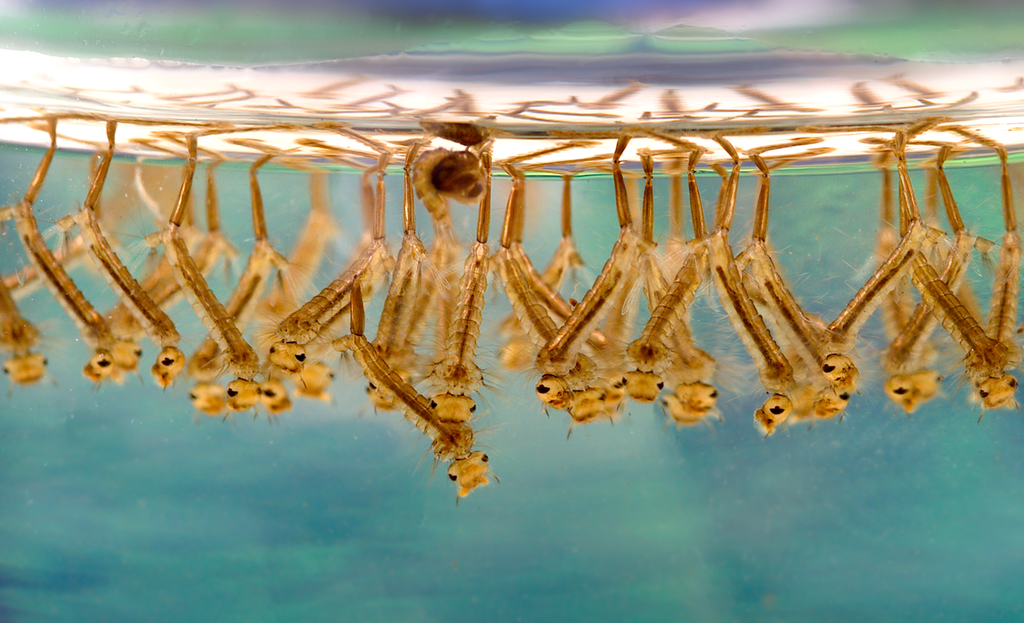How to Get Rid of Mosquito Larvae in Pond Water (Best Methods)
Pond Academy is reader-supported. Buying through links on our site may earn us an affiliate commission. As an Amazon Associate I earn from qualifying purchases.
Ponds are a beautiful and tranquil addition to any backyard, especially in spring and summer when the plants are in full bloom and the fish are busy.
But, if conditions are right, it’s also the time when mosquitoes may use your pond as their breeding grounds.
And while they may be annoying, they can also be dangerous as mosquitoes can pass along viruses such as Zika and West Nile.
So, let's look at how to get rid of mosquito larvae in a pond and make sure they never breed there again.
How To Kill Mosquito Larvae In A Pond Naturally

To kill mosquito larvae in a pond and keep them from coming back, you need to make the environment unappealing by creating movement and reducing vegetation, removing their food sources, and using control methods like mosquito-eating fish and natural repellents.
Let’s break these down into five quick and easy steps that’ll kill mosquito larvae naturally and keep mosquitoes from returning.
Step 1: Create Movement In Your Pond
Female mosquitoes look for stagnant water rich in nutrients like algae and bacteria to lay their eggs. The larvae and pupae survive and thrive in this environment until they become full-grown mosquitoes. And the cycle continues…
An easy way to stop that cycle is to introduce water flow and movement to your pond with a pond aeration system, pump, or water features such as a fountain or waterfall.
Whether you use a pond pump to cycle your pond’s water through a filter or a pond aerator to add oxygen to your pond, both will create the movement needed to stop mosquitoes from laying their eggs.
Waterfalls, fountains, and even decorative pond spitters are great ways to get the necessary water movement to keep mosquitoes away and add aeration to your pond. They make great pond decorations, as well! You can even add movement at a zero-running cost with a solar fountain pump.
Step 2: Add Mosquito Dunks
Mosquito dunks are an effective and natural organic way to kill mosquito larvae still in the feeding stage. These donut-shaped “dunks” contain BTI bacteria that is lethal to larvae.
Simply drop one into your pond or water garden and it’ll start working within hours. One dunk will last up to 30 days and treat 100 square feet of surface water.
And don’t worry, they are non-toxic to pond fish, pets, and other animals.
Step 3: Remove Mosquito Larvae Food Sources
Like all living things, larvae need nutrients to grow and thrive. These nutrients come in the form of algae and other bacteria in your pond. By keeping your pond clean and controlling algae and muck, you will effectively limit the number of nutrients the larvae need to survive.
If pond scum and algae are a problem in your pond, check out our guide on how to get rid of algae in a pond.
Step 4: Introduce Mosquito Eating Fish
Many fish like koi, goldfish, bluegill, guppies, catfish, and especially mosquitofish (gambusia affinis) love to eat mosquito larvae and help keep them in check. And some fish, like koi and goldfish, are natural pond algae eaters, which will help reduce the nutrients that larvae love to eat.
Step 5: Reduce Vegetation
Mosquito larva need to live in water to thrive and grow. Adult mosquitoes, on the other hand, prefer to live in the vegetation along the shoreline of your pond. That doesn’t mean you need to get rid of your pond’s plants, instead, rid your shoreline of aquatic weeds and grass. Check out our pond weed control guide to easily identify the weeds around your pond and how to remove them quickly and easily.
Get Our Best Pond Tips Sent to Your Inbox for Free!
Join thousands of others and learn from our decades of pond building and maintenance experience! Your pond will thank you!
By subscribing you agree to receive emails from PondAcademy.com. We will always respect your privacy and you can unsubscribe at any time.
What To Put In Standing Water To Kill Mosquitoes
If you have standing water near your pond, like in a trough, water barrel, some larger bird feeders, or a small pot-sized water garden where mosquitoes are starting to breed, you’ll want to kill those larvae as they can spread to your pond.
In these instances, adding aeration, fish, and trimming back vegetation might not be an option, so what can we put in the water to kill the larvae? While you may have heard of various remedies online like adding cinnamon, apple cider vinegar, or even Epsom salt to standing water, there are two easy and natural ways that we’ve found work wonders.
Mosquito Dunks & Bits
As we mentioned above, mosquito dunks are a super-effective way to kill feeding larvae naturally. Mosquito Bits are a similar form of pest control as Dunks, just in a smaller “bit” size. Mosquito Bits may work better for you if you just want to use a minimal amount of bits to treat a small amount of standing water.
Vegetable Oil
It may seem odd, but a light spray of vegetable cooking oil on the surface of the standing water is an effective home remedy to control mosquito larvae. The non-toxic oil will suffocate the insect larvae by blocking the larvae’s breathing tubes that protrude from the water's surface. The oil will evaporate in a few days or be cleaned up by the pond’s filter.
Will Bleach Kill Mosquito Larvae?
Bleach will effectively kill mosquito larvae. However, do not use this method for your pond or water garden, as bleach is toxic and will kill any wildlife and organisms. There are much more natural and safer methods that are just as effective as bleach that you should use to control pests.
How Do I Stop Mosquitos From Breeding In My Pond Again?
Once you’ve successfully gotten rid of the mosquito larvae, you’ll want to keep mosquitos out and away from your pond so they don’t try to breed in your pond's water again. We focused on these methods in our guide to killing mosquito larvae in ponds above, but it’s important to touch on them again if you really want to make sure the mosquitos don’t return to your pond.
- Aeration & Movement: As we mentioned above, mosquitoes prefer stagnant water, so you can effectively stop mosquitoes from coming back to your pond to breed by creating water movement via a pond aeration system, pond pump, or water features like a fountain or waterfall. Even if you have movement in the majority of your pond, all it takes is a small section of your pond's surface to be stagnant for mosquitoes to start breeding.
- Fish & Wildlife: Bats, fish and other wildlife enjoy feeding on mosquitoes. By attracting and adding these creatures around and in your pond, you can effectively control your mosquito nuisance. For example, adding or boosting mosquito-eating fish to your pond will help stop mosquitoes from using it as their breeding grounds.
- Algae Control: Mosquito larvae love to feed on the nutrients in your pond or water garden. If you keep your pond's algae levels under control, you will starve the larvae of the nutrients they need to survive. Ensure you have adequate pond filtration, add some plants to your pond, and use some barley straw to help ensure algae doesn’t return.
- Reduce Vegetation: Mosquitoes like to hide in the weeds around your pond and along the shoreline. So, you’ll want to evict them before they can start using your pond as a breeding ground. Remove these weeds, manually if possible, with clippers, a pond rake, or a skimmer. If you have a weed infestation beyond manual removal, you might want to try an aquatic herbicide like Catt Plex, which is safe for humans and fish.











